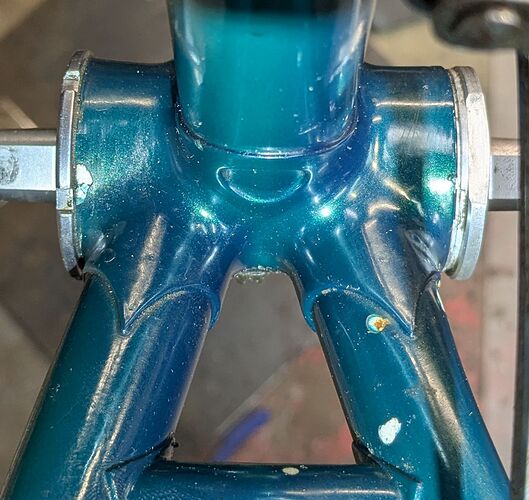Filing lugless fillets inevitably thins the steel, right at the worst place, in the HAZ where the tube is already weakened.
Best way to make a lugless frame is with small neat fillets that don’t need any post-braze shaping. It’s OK to cheat a bit until you get your fillet game up to snuff, but I recommend leaving a little for the painter to do with putty, rather than trying to make perfect “show” fillets. If powercoating, JBweld works for fairing in fillets, doesn’t melt in the paint curing oven.
Another caveat while your fillets aren’t perfect enough to leave them alone: don’t use the thinnest tubes. Consider going down one size in diameter and up a notch or two on the thickness, for some safety margin in case your shaping thins the tube a bit at the fillet edge.
I encourage all FBs to make sample fillet-brazed joints and break them in a vise with cheaterbars, to see how small a fillet you can get away with. If the fillet breaks, it wasn’t big enough, but I think you’ll find they can be pretty small and the tubing still fails before the fillet.
Smaller fillets add less weight to the frame but more importantly they add less thermal mass and less heat overall, so the joint cools more rapidly. Smaller HAZ with less tempering. Less grain growth/recrystallization.
So the frame ends up stronger with smaller fillets — right down to the point where they’re too small and it’s the fillet that breaks. So ideally you want the size barely above that minimum.
That said, you don’t have to flirt with the absolute smallest. It makes you look bad if a fillet breaks, so err on the side of a bit too big to ensure its’s always the tube that fails before the fillet.
Another option, especially if you have odd angles and there’s no lugged shell that fits, is make your own lugged shell. Then the fillet shaping is done on the lug sockets, no chance of thinning the tubes. It’s a lot of work though! Here’s one I did that way in '84, got that out of my system so I never needed to do another one!
If you brass-fillet the sockets to the shell, then you can silver braze the tubes in after the shell is all shaped and finished. It’s less work to do it “bilam” style though, sliding the sockets over the tubes then brazing it all in one heat-cycle
